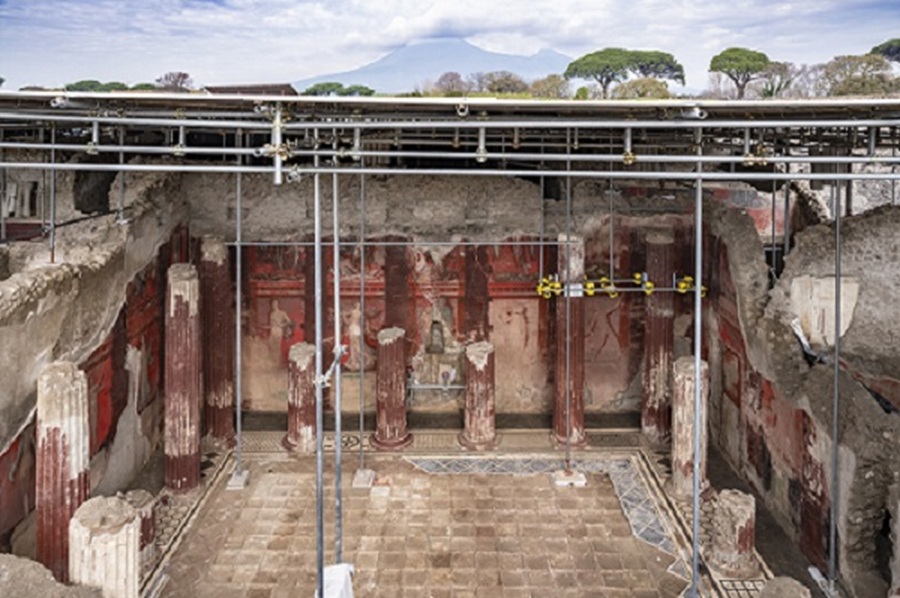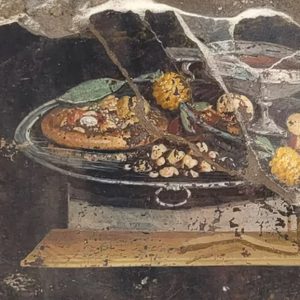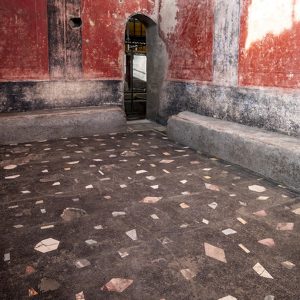Archaeologists at Pompeii have uncovered a remarkable fresco depicting Dionysiac initiation rites, offering fresh insight into ancient mystery cults. The discovery was made in a large banqueting hall within Insula 10 of Region IX, an area currently under excavation in the heart of the ancient city.
The Dionysiac fresco is an almost life-size frieze known as a “megalography”. It runs along three walls of the room, with the fourth side opening onto a garden. Dating to the 40s-30s BC, it is the first major example of its kind found in Pompeii since the Villa of the Mysteries over a century ago.
Depictions of Dionysiac Rites
The frieze illustrates a Dionysiac procession filled with movement and emotion. Bacchantes, or maenads, appear both as dancers and hunters, carrying slain kid goats or wielding weapons. Satyrs with pointed ears play the double flute, while another acrobatically pours a wine libation. At the centre, a woman accompanied by an old Silenus holds a torch. This marks her initiation into the cult of Dionysus, the god associated with death and rebirth.


The figures are placed on pedestals, resembling statues, yet their expressions and clothing create a lifelike effect. Above the main fresco, a smaller frieze depicts animals—some alive, others slaughtered—including a fawn, a wild boar, birds, fish, and seafood. This hunting imagery, absent in the Villa of the Mysteries, adds a new dimension to our understanding of Dionysiac rituals.
Significance of the Discovery
Minister of Culture Alessandro Giuli hailed the find as historic, noting Pompeii continues to provide invaluable glimpses into the rituals of the ancient world. “The megalography in Insula 10 of Region IX enhances our understanding of Dionysiac mysteries and strengthens Pompeii’s status as a unique archaeological treasure,” he stated. He also highlighted government support for excavations, with €33 million allocated for further work, preservation, and restoration.
Gabriel Zuchtriegel, director of the Archaeological Park of Pompeii, linked the frescoes to themes explored in Euripides’ tragedy The Bacchae (405 BC). He described the bacchante as a symbol of untamed female energy, contrasting with the idealised, domestic Venus. “These paintings play with illusion and reality while reflecting a broader religious crisis of the time,” he explained.
Ongoing Excavations in Region IX
Excavations in Region IX, which began in February 2023, cover 3,200 square metres. Recent discoveries include atrium houses dating to the Samnite period, later converted into workshops such as a bakery and a laundry. Additional rooms have revealed frescoes depicting the Trojan War, agricultural allegories, and a large bath complex.
The excavation is now in its final phase. It is focusing on safety measures before a long-term conservation project ensures full public access. With over 50 newly uncovered rooms spanning 1,500 square metres, archaeologists anticipate further significant revelations about life in ancient Pompeii.
Access to the Site
The House of Thiasus, as the residence has been named, is now open for public viewing. Guided tours take place Monday to Friday at 11:00 am, with access for two groups of 15 visitors per session. Entry requires a standard ticket to the Pompeii Archaeological Park, and reservations can be made by calling 327 2716666.





